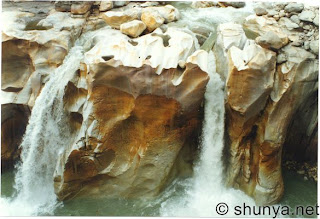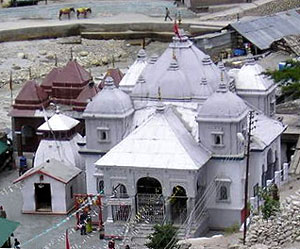Badrintah Dham: "Badrinath Dham” Guarded on either side by the two mountains Nar and Narayan, the Neelkanth Peak provides a splendid backdrop to Badrinath, one of the 'Four Dhams'. One of the most celebrated pilgrim spots in the country, it plays host to the famous Badrinath Temple. Legend has it that Lord Vishnu came to the area, called ‘Badri Van’, or the berry garden, to meditate after Narad rebuked the Lord for being immersed in worldly pleasures. The main deity is a meditating Lord Vishnu. Badrinath dhaam is considered as one of the most sacred centres of pilgrimage situated in the lofty Himalayan heights in the Tehri-Garhwal hill tracks (Uttarakhand) at the height of 10,248 feet above sea level. The route to Badrinath is one of the most arduous one due to the lofty hilly terrain, curves and cliffs amidst the most scenically beautiful place on the earth.
Badrintah Temple :The temple at the bank of Alaknanda River is a hot water spring known as "Tapt Kund", a bath in which is very refreshing to all travellers. Dedicated to Lord Vishnu, the temple of Shri Badrinathji, is 5 m high, built in the form of a cone with a small cupola of a gilt bull and spire. The temple opens every year in the month of April-May and closes for winters in the third week of November. Even though legend dates the temple back to the Vedic age, Guru Adi Shankaracharya has established the present temple. The temple has three parts - Garbha Grih (The Sanctum Sanctorum), Darshan Mandap (for pujas) and Sabha Mandap (for devotees to assemble).The Badrinath temple was constructed and renovated by Shankaracharya some time in 8th century during his pilgrimage to Badrinath and Kedarnath after he had established 'Jyotirdham' in Joshimath. Narada Kund, Surya Kund, Basudhara, Mata Murti and Charan Paduka are the other holy places of attraction for the large number of pilgrims who visit Badrinath every year. About 8 kms from Badrinath in the west, there is a group of snow peak called Choukhamba with height up to 6700 m. There is another peak called Neelkantha about 9 km. south west of Badrinath. The temple of Badrinath is visited by about six lakh pilgrims every year. There is a plan to make a village complex for the pilgrims at an estimated cost of rupees one crore. Presently hotel Devlok has been constructed at Badrinath to provide board and lodging facilities to pilgrims.
Place to visit in Badrinath /Sightseeing/Excursions
Badri Vishal : Main shrine of Lord Badrinath ji is known as 'Badrinath'
Bhavishya Badri : The temple of Bhavishya Badri is at an elevation 3641 m, and is surrounded by dense forests. It is located at Subain near Tapovan, about 17 km east of Joshimath on Joshimath-Lata Malari route. Pilgrims have to trek beyond Tapovan, up the Dhauliganga river.
It is believed that a day will come when the present route to Badrinath will become inaccessible and Lord Badrinath will then be worshipped here. Hence the name 'Bhavishya Badri', which literally means the "Future Badri".
Yogdhyan Badri : The temple of Yog Dhyan Badri, one of the five Badris is located at Pandukeshwar (1920 m), just 24 km short of Badrinath on Rishikesh-Badrinath highway. The image, depiciting a meditative posture of the Lord, is worshipped here. The Pandavas are said to have handed over Hastinapur to King Parikshit and retired here
Vridha Badri : Situated at an altitude of 1380 m and at a distance of 7 km from Joshimath is Animath, the place where several centuries before the advent of Adi Guru Shankaracharya, the idol of Badrinath was enshrined and worshipped. The idol is known as Vriddha (old) or the first Badri and the temple remains open throughout the year
Adi-Badri : Adi-Badri is 19 km away trom Karanprayag on Chaukuthia Ranikhet road where a group of 16 temples dating back to Gupta age are in existance. These temples were made with the idol of lord Vishnu to spread Hinduism to every remote comer in the country by Adi-Shankaracharya
Panch Dharas : (a) Prahalad Dhara (b) Kurma Dhara (c) Urvashi Dhara (d) Bhrigu Dhara (e) Indra Dhara
Panch Shilas : (a) Narad Shila (b) varaha Shila (c) Garurh Shila (d) Markandeya Shila (e) Narshingh Shila
Tapt Kund : Tapt kund is a natural hot water pool fed by a sulphur spring which is said to be the abode of Agni, the god of fire. It is customary to bathe before entering Sri Badrinath temple. This water has a temperature of 130 degrees C. To the left of this pool is the Surya Kund fed by a branch of the same thermal spring. These waters are said to be very nourishing to the body. The Alakananda flows swiftly just below these kunds and the boiling water falls into the icy waters of the river giving rise to clouds of steam.
Narad Kund : A recess in the river, near Tapt Kund, forming a pool from where the Badrinath idol was recovered. It is sheltered by a projecting rock which breaks the force of the river and allows people to bathe in it. Adi Shankaracharya knew this by his great powers and retrieved the idol from this pool
Brahama Kapal : To the north of Sri Badrinath temple is the spot known as Brahma Kapal where Lord Brahma is said to reside. Ceremonies for departed souls are performed
Sheshnetra : 1.5 km away is a boulder having an impression of the legendary snake, better known as the Sheshnag’s eye (Shesh meaning Sheshnag and Netra meaning eye).
Charanpaduka : 3 km away is a beautiful meadow carpeted with wild flowers in the summer. Here is a boulder bearing the footprints of Lord Vishnu. It is said that when Lord Vishnu descended from Vaikunth (the heavenly abode of Lord Vishnu) he stepped on this boulder. The area is a steep climb from the town and is full of caves & boulders :
Mata Murty Temple : Devoted to the mother of Sri Badrinathji. Other important temples include Sesh Netra Temple, Urvashi Temple and Charanpaduka.
Mana Village : Inhabited by an Indo-Mongolian tribe, it is the last Indian village before Tibet.
Vasundhara : As the name suggests, vasundhara is a magnificent water fall. This place is 5 kms. from Badrinath out of which 2 kms. is motorable upto Mana.
Bhim Pul : On the other side of Mana village, a massive rock forming a natural bridge, lies over the roaring Saraswati river. It presents a spectacular view of water thundering down through the narrow passage under the rock and is believed to have been placed there by Bhim, the second eldest among the five Pandava brothers.
Vyas Gufa (cave) : Near Mana Village, this is a rock-cave where Ved Vyas is believed to have composed the Mahabharata and the pauranic commentaries
General information
Area: 4.5 Sq.kms.
Altitude : 3133 mts.
Rainfall : 1460 m
Temperature : Summer - Max 17.9° C, Min 5.9° C, Winter- Generally snowbound from December to March with minimum subzero temperature.
Best Season : From opening to closing, generally from April to November.
Clothing : Heavy woolen garments required throughout.
Accessibility
Air : Nearest airport is a Jollygrant, 314kms.
Rail : Nearest railhead is Rishikesh, 297kms. which is connected to major cities like Howrah, Mumbai, Delhi & Lucknow by rail.
Road : Badrinath is connected by a motorable road with Rishikesh, Kotdwar, Dehradun, Haridwar and other hill stations of Garhwal. Some important road distances are Delhi (518Kms), Joshimath (42Kms), Hardwar (321 Kms), Gopeshwar (106 Kms). 

















